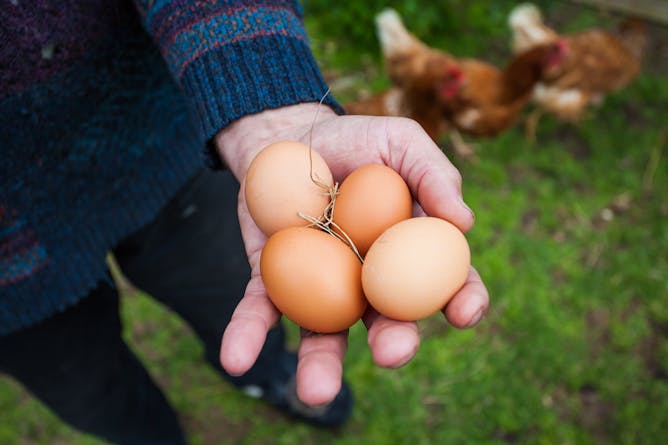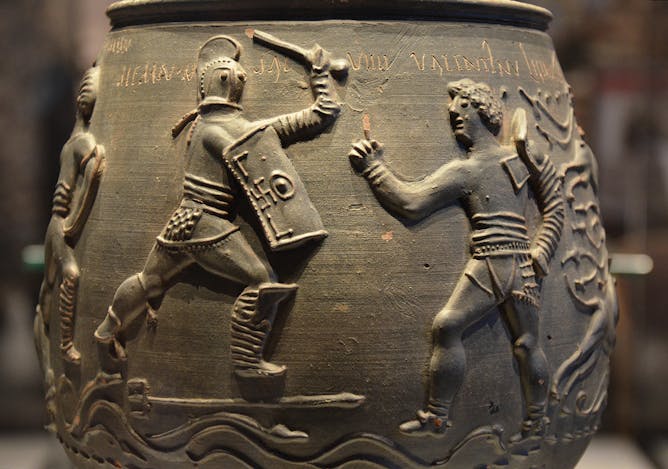|
Hens in England have been housed indoors since November to limit the spread of bird flu, which is devastating populations of wild birds and mammals as well as farmed animals. Customers used to free-range eggs might not like buying produce from chickens which cannot leave their cramped confines. But a closer inspection of this label – and how it came to dominate supermarket shelves – reveals an uncomfortable truth about the history of egg farming.
The rise of free-range farms, which produced 1% of all eggs sold across the UK in 1980 and 60% in 2021, was largely a reaction to public health scares about salmonella in barns during the late 80s, according to University of Liverpool historian Joel Mead. Despite animal welfare having a marginal role in this transformation, customers are likely to consider free-range the ethical choice. But, as Mead explains, the reality for free-range chickens is often far from
the advertised scenes of a life roaming happily in open fields.
The recent collapse of US-based Silicon Valley Bank took many by surprise. We hear from an economics and history expert about the causes and what’s likely to happen next. And a Roman vase found in Colchester which appeared to depict gladiator fights was recently used as evidence that Britain hosted the brutal games. Turns out it’s not the only evidence.
|

|
Jack Marley
Environment + Energy Editor
|
|

MJHeritage/Shutterstock
Joel Mead, University of Liverpool
Though preferable to battery farms, free-range eggs are not as safe and ethical as customers think.
|

SOPA Images Limited/Alamy Stock Photo
Charles Read, University of Cambridge
The speed of SVB’s collapse was a surprise but central bankers can learn lessons from this failure.
|

The Colchester vase, dating to the later second century AD.
Following Hadrian/Flickr
Simon Esmonde Cleary, University of Birmingham
The Colchester vase contains the remains a male of about 40 years of age and not of local origin. Could he have been a gladiator?
|
Politics + Society
|
-
Stefan Wolff, University of Birmingham
There are fears that Russia might try to compensate for its poor performance in Ukraine by upping its meddling in neighbouring countries.
-
Simon Mabon, Lancaster University
Detente between Tehran and Riyadh will not magically solve all the political and sectarian tensions in the Middle East.
-
Mark Shucksmith, Newcastle University; Jane Atterton, Scotland's Rural College; Jayne Glass, Uppsala University
High rural poverty rates are driven largely by fuel and transport costs.
|
|
Arts + Culture
|
-
Keith McDonald, York St John University
Del Toro’s Pinocchio stands out because it couples existential issues with real-world historical catastrophes.
-
Helen Julia Minors, York St John University
Moving the voting system away from experts could be interpreted as a tactic to include American audiences.
|
|
Business + Economy
|
-
Steve Schifferes, City, University of London
He steadied the ship in the autumn. Can he now turn around the Conservatives’ electoral fortunes?
|
|
Education
|
-
Martin Doherty, University of East Anglia
At about four, children start to understand that someone’s behaviour depends on what that person believes.
|
|
Environment
|
-
Morgiane Noel, Trinity College Dublin
Why the UN Refugee Convention should be updated to protect climate migrants.
|
|
Science + Technology
|
-
Ken Drinkwater, Manchester Metropolitan University; Andrew Denovan, University of Huddersfield; Neil Dagnall, Manchester Metropolitan University
We’ve spent ages learning about the people who think they’ve come from another planet, so you don’t have to.
|
|
|
|
| |
|
|
14 March 2023
•
Manchester
|

|
23 March 2023
•
Manchester
|

|
28 March 2023
•
Birmingham
|

|
11 April 2023
•
Manchester
|

|
|
|
|
| |
| |
| |
| |
| |
|
|